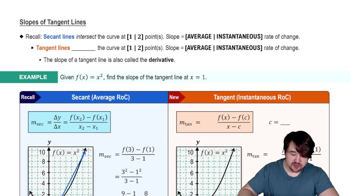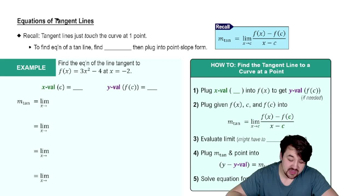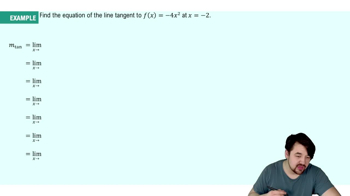Table of contents
- 0. Functions7h 52m
- Introduction to Functions16m
- Piecewise Functions10m
- Properties of Functions9m
- Common Functions1h 8m
- Transformations5m
- Combining Functions27m
- Exponent rules32m
- Exponential Functions28m
- Logarithmic Functions24m
- Properties of Logarithms34m
- Exponential & Logarithmic Equations35m
- Introduction to Trigonometric Functions38m
- Graphs of Trigonometric Functions44m
- Trigonometric Identities47m
- Inverse Trigonometric Functions48m
- 1. Limits and Continuity2h 2m
- 2. Intro to Derivatives1h 33m
- 3. Techniques of Differentiation3h 18m
- 4. Applications of Derivatives2h 38m
- 5. Graphical Applications of Derivatives6h 2m
- 6. Derivatives of Inverse, Exponential, & Logarithmic Functions2h 37m
- 7. Antiderivatives & Indefinite Integrals1h 26m
2. Intro to Derivatives
Tangent Lines and Derivatives
Problem 3.2.43a
Textbook Question
Use the definition of the derivative to determine d/dx(ax²+bx+c), where a, b, and c are constants.
 Verified step by step guidance
Verified step by step guidance1
Step 1: Recall the definition of the derivative. The derivative of a function f(x) at a point x is given by the limit: \( f'(x) = \lim_{h \to 0} \frac{f(x+h) - f(x)}{h} \).
Step 2: Identify the function f(x) = ax^2 + bx + c. We need to find f(x+h) by substituting x with (x+h) in the function: f(x+h) = a(x+h)^2 + b(x+h) + c.
Step 3: Expand f(x+h). Use the distributive property to expand: a(x+h)^2 = a(x^2 + 2xh + h^2), and b(x+h) = bx + bh. So, f(x+h) = ax^2 + 2axh + ah^2 + bx + bh + c.
Step 4: Substitute f(x) and f(x+h) into the derivative definition: \( f'(x) = \lim_{h \to 0} \frac{(ax^2 + 2axh + ah^2 + bx + bh + c) - (ax^2 + bx + c)}{h} \).
Step 5: Simplify the expression inside the limit. Cancel out the terms ax^2, bx, and c, and then divide each remaining term by h: \( f'(x) = \lim_{h \to 0} \frac{2axh + ah^2 + bh}{h} = \lim_{h \to 0} (2ax + ah + b) \). Finally, evaluate the limit as h approaches 0.
Recommended similar problem, with video answer:
 Verified Solution
Verified SolutionThis video solution was recommended by our tutors as helpful for the problem above
Video duration:
4mPlay a video:
Was this helpful?

 5:13m
5:13mWatch next
Master Slopes of Tangent Lines with a bite sized video explanation from Nick
Start learningRelated Videos
Related Practice




